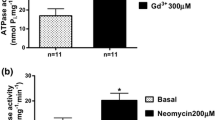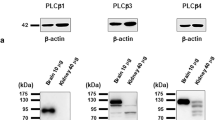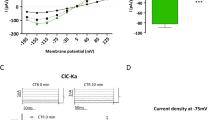Abstract
Lysophosphatidic acid (LPA) acts through the activation of G protein-coupled receptors, in a Ca2+-dependent manner. We show the effects of LPA on the plasma membrane Ca2+-ATPase (PMCA) from kidney proximal tubule cells. The Ca2+-ATPase activity was inhibited by nanomolar concentrations of LPA, with maximal inhibition (~50%) obtained with 20 nM LPA. This inhibitory action on PMCA activity was blocked by Ki16425, an antagonist for LPA receptors, indicating that this lipid acts via LPA1 and/or LPA3 receptor. This effect is PKC-dependent, since it is abolished by calphostin C and U73122, PKC, and PLC inhibitors, respectively. Furthermore, the addition of 10−8 M PMA, a well-known PKC activator, mimicked PMCA modulation by LPA. We also demonstrated that the PKC activation leads to an increase in PMCA phosphorylation. These results indicate that LPA triggers LPA1 and/or LPA3 receptors at the BLM, inducing PKC-dependent phosphorylation with further inhibition of PMCA. Thus, LPA is part of the regulatory lipid network present at the BLM and plays an important role in the regulation of intracellular Ca2+ concentration that may result in significant physiological alterations in other Ca2+-dependent events ascribed to the renal tissue.





Similar content being viewed by others
References
Aikawa S, Hashimoto T, Kano K, Aoki J (2015) Lysophosphatidic acid as a lipid mediator with multiple biological actions. J Biochem 157:81–89
Aoki J (2004) Mechanisms of lysophosphatidic acid production. Semin Cell Dev Biol 15:477–489
Aoki J, Taira A, Takanezawa Y, Kishi Y, Hama K, Kishimoto T, Mizuno K, Saku K, Taguchi R, Arai H (2002) Serum lysophosphatidic acid is produced through diverse phospholipase pathways. J Biol Chem 277:48737–48744
Aoki J, Inoue A, Okudaira S (2008) Two pathways for lysophosphatidic acid production. Biochim Biophys Acta 1781:513–518
Assunção-Miranda I, Guilherme AL, Reis-Silva C, Costa-Sarmento G, Oliveira MM, Vieyra A (2005) Protein kinase C-mediated inhibition of renal Ca2+-ATPase by physiological concentrations of angiotensin II is reversed by AT1- and AT2-receptor antagonists. Regul Pept 127:151–157
Axelband F, Assunção-Miranda I, De Paula IR, Ferrão FM, Dias J, Miranda A, Miranda F, Lara LS, Vieyra A (2009) Ang-(3-4) suppresses inhibition of renal plasma membrane calcium pump by Ang II. Regul Pept 155:81–90
Baker DL, Desiderio DM, Miller DD, Tolley B, Tigyi GJ (2001) Direct quantitative analysis of lysophosphatidic acid molecular species by stable isotope dilution electrospray ionization liquid chromatography-mass spectrometry. Anal Biochem 292:287–295
Becker KP, Hannun YA (2005) Protein kinase C and phospholipase D: intimate interactions in intracellular signaling. Cell Mol Life Sci 62:1448–1461
Bian D, Su S, Mahanivong C, Cheng RK, Han Q, Pan ZK, Sun P, Huang S (2004) Lysophosphatidic acid stimulates ovarian cancer cell migration via a Ras-MEK kinase 1 pathway. Cancer Res 64:4209–4217
Cabral LMP, Wengert M, Da Ressurreição AA, Feres-Elias PHP, Almeida FG, Vieyra A, Caruso-Neves C, Einicker-Lamas M (2007) Ceramide is a potent activator of plasma membrane Ca2+-ATPase from kidney proximal tubule cells with protein kinase A as an intermediate. J Biol Chem 282:24599–24606
Cabral LMP, Wengert M, Almeida FG, Caruso-Neves C, Vieyra A, Einicker-Lamas M (2010) Ceramide-activated protein kinases A and C zeta inhibit kidney proximal tubule cell Na+-ATPase. Arch Biochem Biophys 498:57–61
Choi JW, Herr DR, Noguchi K, Yung YC, Lee CW, Mutoh T, Lin ME, Teo ST, Park KE, Mosley AN, Chun J (2010) LPA receptors: subtypes and biological actions. Annu Rev Pharmacol Toxicol 50:157–186
Coelho-Sampaio T, Teixeira-Ferreira S, Vieyra A (1991) Novel effects of calmodulin and calmodulin antagonists on the plasma membrane (Ca2++Mg2+)-ATPase from rabbit kidney proximal tubules.J. Biol Chem 266:10249–10253
Coka-Guevara S, Markus RP, Caruso-Neves C, Lopes AG, Vieyra A (1999) Adenosine inhibits the renal plasma-membrane (Ca2++Mg2+)-ATPase through a pathway sensitive to cholera toxin and sphingosine. Eur J Biochem 263:71–78
Contos JJ, Chun J (2001) The mouse LPA(3)/Edg7 lysophosphatidic acid receptor gene: genomic structure, chromosomal localization, and expression pattern. Gene. 267:243–253
Einicker-Lamas M, Wenceslau LD, Bernardo RR, Nogaroli L, Guilherme A, Oliveira MM, Vieyra A (2003) Sphingosine-1-phosphate formation activates phosphatidylinositol-4 kinase in basolateral membranes from kidney cells: crosstalk in cell signaling through sphingolipids and phospholipids. J Biochem 134:529–536
Escribá PV, Wedegaertner PB, Goñi FM, Vögler O (2007) Lipid-protein interactions in GPCR-associated signaling. Biochim Biophys Acta Biomembr 1768:836–852
Futerman AH, Hannun YA (2004) The complex life of simple sphingolipids. EMBO Rep 5:777–782
Hao F, Tan M, Wu DD, Xu X, Cui MZ (2010) LPA induces IL-6 secretion from aortic smooth muscle cells via an LPA1-regulated, PKC-dependent, and p38alpha-mediated pathway. Am J Physiol Heart Circ Physiol 298:H974–H983
Hla T, Maciag T (1990) An abundant transcript induced in differentiating human endothelial cells. J Biol Chem 265:9308–9313
Hokin MR, Hokin LE (1954) Effects of acetylcholine on phospholipids in the pancreas. J Biol Chem 209:549–558
Hope JM, Wang FQ, Whyte JS, Ariztia EV, Abdalla W, Long K, Fishman DA (2009) LPA receptor 2 mediates LPA-induced endometrial cancer invasion. Gynecol Oncol 112:215–223
Inoue M, Xie W, Matsushita Y, Chun J, Aoki J, Ueda H (2008) Lysophosphatidylcholine induces neuropathic pain through an action of autotaxin to generate lysophosphatidic acid. Neuroscience. 152:296–298
Kihara Y, Maceyka M, Spiegel S, Chun J (2014) Lysophospholipid receptor nomenclature review: IUPHAR Review 8. Br J Pharmacol 171:3575–3594
Kihara Y, Mizuno H, Chun J. (2014) Lysophospholipid receptors in drug discovery, Exp. Cell Res 333:171–177
Laemmli UK (1970) Cleavage of structural proteins during the assembly of the head of bacteriophage T4. Nature 227:680–685
Lemos T, Verdoorn KS, Nogaroli L, Britto-Borges T, Bonilha TA, Moreno PAM, Silva OF, Tortelote GG, Einicker-Lamas M (2014) Biphasic regulation of type II phosphatidylinositol-4 kinase by sphingosine: cross talk between glycero- and sphingolipids in the kidney. Biochim Biophys Acta 1838:1003–1009
Líbano-Soares JD, Gomes-Quintana E, Melo HK, Queiroz-Madeira EP, Roubach RG, Lopes AG, Caruso-Neves C (2008) B2 receptor-mediated dual effect of bradykinin on proximal tubule Na+-ATPase: sequential activation of the phosphoinositide-specific phospholipase Cβ/protein kinase C and Ca2+-independent phospholipase A2 pathways. Biochim Biophys Acta 1778:1316–1326
Lin S, Yeruva S, He P, Singh AK, Zhang H, Chen M, Lamprecht G, De Jonge HR, Tse M, Donowitz M, Hogema BM, Chun J, Seidler U, Yun CC (2010) Lysophosphatidic acid stimulates the intestinal brush border Na(+)/H(+) exchanger 3 and fluid absorption via LPA(5) and NHERF2. Gastroenterol. 138:649–658
Lowry OH, Rosebrough NJ, Farr AL, Randall RJ (1951) Protein measurement with the Folin phenol reagent. J Biol Chem 193:265–275
Meyer zu Heringdorf D, Jakobs KH (2007) Lysophospholipid receptors: signalling, pharmacology and regulation by lysophospholipid metabolism. Biochim Biophys Acta 1768:923–940
Mochly-Rosen D, Das K, Grimes KV (2012) Protein kinase C, an elusive therapeutic target? Nat Rev Drug Discov 11:937–957
Newton AC (2003) Regulation of the ABC kinases by phosphorylation: protein kinase C as a paradigm. Biochem J 370:361–371
Nogaroli L, Silva OF, Bonilha TA, Moreno PAM, Bernardo RR, Vieyra A, Einicker-Lamas M (2005) Diacylglycerol kinase activity in purified basolateral membranes of kidney tubules: I. Evidence for coupling with phospholipase C, Int. J Biochem Cell Biol 37:79–90
Ohata H, Tanaka K, Aizawa H, Ao Y, Iijima T, Momose K (1997) Lysophosphatidic acid sensitises Ca2+ influx through mechanosensitive ion channels in cultured lens epithelial cells. Cell Signal 9:609–616
Ohta H, Sato K, Murata N, Damirin A, Malchinkhu E, Kon J, Kimura T, Tobo M, Yamazaki Y, Watanabe T, Yagi M, Sato M, Suzuki R, Murooka H, Sakai T, Nishitoba T, Im DS, Nochi H, Tamoto K, Tomura H, Okajima F (2003) Ki16425, a subtype-selective antagonist for EDG-family lysophosphatidic acid receptors. Mol Pharmacol 64:994–1005
Park F, Miller DD (2017) Role of lysophosphatidic acid and its receptors in the kidney. Physiol Genomics 49:659–666
Parkinson NA, James AF, Hendry BM (1996) Actions of endothelin-1 on calcium homeostasis in Madin-Darby canine kidney tubule cells. Nephrol DialTransplant 11:1532–1537
Parrill AL, Tigyi G (2013) Integrating the puzzle pieces: the current atomistic picture of phospholipid–G protein coupled receptor interactions. Biochim Biophys Acta 1831:2–12
Pradère JP, Klein J, Grès S, Guigné C, Neau E, Valet P, Calise D, Chun J, Bascands JL, Saulnier-Blache JSB, Schanstra JP (2007) LPA1 receptor activation promotes renal interstitial fibrosis. J Am Soc Nephrol 18:3110–3118
Rhee HJ, Nam JS, Sun Y, Kim MJ, Choi HK, Han DH, Kim NH, Huh SO (2006) Lysophosphatidic acid stimulates cAMP accumulation and cAMP response element-binding protein phosphorylation in immortalized hippocampal progenitor cells. Neurorep. 17:523–526
Streb SLH, Irvine RF, Berridge MJ (1983) Release of Ca2+ from non mitochondrial intracellular store in pancreatic acinar cells by inositol-1,4,5- trisphosphate. Nature. 306:67–69
Tager AM, LaCamera P, Shea BS, Campanella GS, Selman M, Zhao Z, Polosukhin V, Wain J, Karimi-Shah BA, Kim ND, Hart WK, Pardo A, Blackwell TS, Xu Y, Chun J, Luster AD (2008) The lysophosphatidic acid receptor LPA1 links pulmonary fibrosis to lung injury by mediating fibroblast recruitment and vascular leak. Nat Med 14:45–54
Takai Y, Kishimoto A, Kikkawa U, Mori T, Nishizuka Y (1979) Unsaturated diacylglycerol as a possible messenger for the activation of calcium-activated, phospholipid-dependent protein kinase system. Biochem Biophys Res Commun 91:1218–1224
Taussky HH, Shorr E (1953) A microcolorimetric method for the determination of inorganic phosphorus. J Biol Chem 202:675–685
Todorova MG, Fuentes E, Soria B, Nadal A, Quesada I (2009) Lysophosphatidic acid induces Ca2+ mobilization and c-Myc expression in mouse embryonic stem cells via the phospholipase C pathway. Cell Signal 21:523–528
Tortelote GG, Valverde RHF, Lemos T, Guilherme A, Einicker-Lamas M, Vieyra A (2004) The plasma membrane Ca2+ pump from proximal kidney tubules is exclusively localized and active in caveolae. FEBS Lett 576:31–35
Verdoorn KS, Lindoso RS, Lowe J, Lara LS, Vieyra A, Einicker-Lamas M (2010) Bone marrow mononuclear cells shift bioactive lipid pattern in injured kidney towards tissue repair in rats with unilateral ureteral obstruction. Nephrol Dial Transplant 25:3867–3874
Vieyra A (1996) Catalytic and structural modifications of sarcoplasmic reticulum and plasma membrane (Ca2++ Mg2+) ATPases induced by organic solutes that accumulate in living systems. Biosci Rep 16:115–127
Vieyra A, Nachbin L, Dios-Abad E, Goldfeld M, Meyer-Fernandes JR, Moraes L (1986) Comparison between calcium transport and adenosine triphosphatase activity in membrane vesicles derived from rabbit kidney proximal tubules. J Biol Chem 261:4247–4255
Whittembury G, Proverbio F (1970) Two modes of Na+ extrusion in cells from guinea pig kidney cortex slices. Eur J Phys 316:1–25
Xu YJ, Saini HK, Cheemab SK, Dhalla NS (2005) Mechanisms of lysophosphatidic acid-induced increase in intracellular calcium in vascular smooth muscle cells. Cell Calcium 38:569–579
Ye X, Skinner MK, Kennedy G, Chun J (2008) Age-dependent loss of sperm production in mice via impaired lysophosphatidic acid signaling. Biol Reprod 79:328–336
Acknowledgements
The authors would like to thank Mr. Celso Pereira for helpful technical services.
Funding
This work was supported by grants from CNPq, CAPES/PROBITEC, and Fundação Carlos Chagas Filho de Amparo a Pesquisa do Estado do Rio de Janeiro (FAPERJ).
Author information
Authors and Affiliations
Contributions
Statement: The authors declare that all data were generated in-house and that no paper mill was used.
JFS: Experimental design, performed experiments, data interpretation, discussion of the results, and written and revision of the manuscript
VSB: Experimental design, performed experiments, data interpretation, and discussion of the results
NAR-G: Experimental design, performed experiments, data interpretation, discussion of the results
TL: Experimental design, performed experiments, data interpretation, and discussion of the results
BLD: Experimental design, performed experiments, data interpretation, discussion of the results, and written and revision of the manuscript
ME-L: Experimental design, performed experiments, data interpretation, discussion of the results, written and revision of the manuscript, and financial support
Corresponding authors
Ethics declarations
Research involving human participants and/or animals
Pig kidneys were purchased from Frigorífico Novo Meriti (São João de Meriti, RJ, Brazil), in accordance to the Federal Law No. 5760, as explained in the “Material and methods” section.
Informed consent
Not applicable
Conflict of interest
The authors declare no competing interest.
Additional information
Publisher’s note
Springer Nature remains neutral with regard to jurisdictional claims in published maps and institutional affiliations.
Highlights
• Lysophosphatidic acid (LPA) can be a modulator of Ca2+-ATPase.
• PKC-dependent control of intracellular Ca2+ in renal cells.
• LPA included in the bioactive lipids network controlling renal function.
Rights and permissions
About this article
Cite this article
Sant’Anna, J.F., Baldez, V.S., Razuck-Garrão, N.A. et al. Lysophosphatidic acid (LPA) as a modulator of plasma membrane Ca2+-ATPase from basolateral membranes of kidney proximal tubules. J Physiol Biochem 77, 321–329 (2021). https://doi.org/10.1007/s13105-021-00800-5
Received:
Accepted:
Published:
Issue Date:
DOI: https://doi.org/10.1007/s13105-021-00800-5




